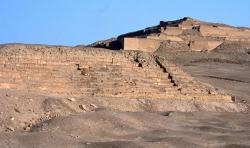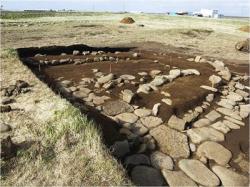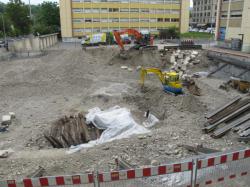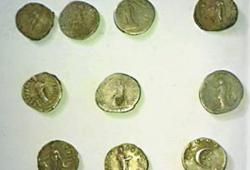INSTITUT SUPERIEUR D'ANTHROPOLOGIE
INSTITUTE OF ANTHROPOLOGY
ONLINE COURSES / COURS A DISTANCE
INSCRIPTION 2012 / Session III : Juillet 2012
REGISTRATION 2012 / Term III : July 2012
PEROU –  Pachacamac - Le Centre de recherches archéologiques (CreA) de l'Université libre de Bruxelles (ULB) a mis au jour un tombeau exceptionnel contenant plus de 80 défunts de différents âges, à Pachacamac (Pérou). La découverte, précise le CreA, est provisoirement datée aux alentours de l'an 1000. Pachacamac, sur la côte Pacifique à quelques kilomètres de Lima, est l'un des plus grands sites précolombiens d'Amérique du Sud. Depuis près de 20 ans, le professeur Peter Eeckhout y conduit des fouilles sous l'égide de l'Université libre de Bruxelles. Au cours de l'expédition 2012, l'équipe du CreA a notamment poursuivi l'exploration d'une nécropole située face au temple de Pachacamac et a mis au jour une grande chambre funéraire de 20m2, totalement intacte et épargnée par les pilleurs. Le tombeau contenait plus de 80 défunts, squelettes et momies, accompagnés de très nombreuses offrandes: vases en céramique, animaux (chien, cochons d'Inde), bijoux en cuivre et en alliage d'or, masques en bois peint, calebasses, etc. Peter Eeckhout et ses collaborateurs poursuivront les études en laboratoire pour répondre aux multiples questions que soulève cette découverte, d'une ampleur jusqu'ici inédite sur le site, précise le CreA.
Pachacamac - Le Centre de recherches archéologiques (CreA) de l'Université libre de Bruxelles (ULB) a mis au jour un tombeau exceptionnel contenant plus de 80 défunts de différents âges, à Pachacamac (Pérou). La découverte, précise le CreA, est provisoirement datée aux alentours de l'an 1000. Pachacamac, sur la côte Pacifique à quelques kilomètres de Lima, est l'un des plus grands sites précolombiens d'Amérique du Sud. Depuis près de 20 ans, le professeur Peter Eeckhout y conduit des fouilles sous l'égide de l'Université libre de Bruxelles. Au cours de l'expédition 2012, l'équipe du CreA a notamment poursuivi l'exploration d'une nécropole située face au temple de Pachacamac et a mis au jour une grande chambre funéraire de 20m2, totalement intacte et épargnée par les pilleurs. Le tombeau contenait plus de 80 défunts, squelettes et momies, accompagnés de très nombreuses offrandes: vases en céramique, animaux (chien, cochons d'Inde), bijoux en cuivre et en alliage d'or, masques en bois peint, calebasses, etc. Peter Eeckhout et ses collaborateurs poursuivront les études en laboratoire pour répondre aux multiples questions que soulève cette découverte, d'une ampleur jusqu'ici inédite sur le site, précise le CreA.
http://www.levif.be/info/belga-generique/decouverte-d-une-tombe-intacte-au-perou-par-des-chercheurs-de-l-ulb/article-4000099985876.htm
ISLANDE –  Hafnir - The first archeological research in Iceland this year will begin at Hafnir in Reykjanes, southwest Iceland, on Monday. Archeologists will continue their study of a hut which may originate from 770-880 AD, the latter part of the Iron Age, and predate the historical settlement of Iceland in 874. Excavation has been ongoing in the area around the hut, which has been given the name Vogur, with intermission since 2003, Fréttablaðið reports. Last summer archeologist Bjarni F. Einarsson revealed that carbon age analysis indicated that the hut may have been constructed in the aforementioned period, which garnered considerable attention. Archeologists now aim to complete research of the hut itself and search for other remains in the area that might date back to the same period.
Hafnir - The first archeological research in Iceland this year will begin at Hafnir in Reykjanes, southwest Iceland, on Monday. Archeologists will continue their study of a hut which may originate from 770-880 AD, the latter part of the Iron Age, and predate the historical settlement of Iceland in 874. Excavation has been ongoing in the area around the hut, which has been given the name Vogur, with intermission since 2003, Fréttablaðið reports. Last summer archeologist Bjarni F. Einarsson revealed that carbon age analysis indicated that the hut may have been constructed in the aforementioned period, which garnered considerable attention. Archeologists now aim to complete research of the hut itself and search for other remains in the area that might date back to the same period.
http://www.icelandreview.com/icelandreview/daily_news/Archeologists_to_Study_Pre_Settlement_Hut_in_Iceland_0_390135.news.aspx
SUISSE – 
 Carouge - Il y a une semaine, les ouvriers d'un chantier ont trouvé des blocs romains erratiques à côté du cimetière israélite. «Une structure en bois longue et large de plusieurs mètres a été découverte dans le cadre d’un chantier locatif», révèle le site 20minutes.ch. C'est près de la piscine de Carouge que la découverte a été faite il y a quelques jours par des ouvriers creusant le sol. A la Cité sarde, on confirme les faits avec enthousiasme. «Lors de travaux d'une entreprise privée, des blocs erratiques de l'époque romaine ont été découverts. Nous en sommes ravis.» Dans le milieu archéologique romand on a entendu parler «de vestiges romains tardifs et peut-être même de quelques restes préhistoriques», dit Véronique Rey-Vodoz, conservatrice du musée romain de Nyon.
Carouge - Il y a une semaine, les ouvriers d'un chantier ont trouvé des blocs romains erratiques à côté du cimetière israélite. «Une structure en bois longue et large de plusieurs mètres a été découverte dans le cadre d’un chantier locatif», révèle le site 20minutes.ch. C'est près de la piscine de Carouge que la découverte a été faite il y a quelques jours par des ouvriers creusant le sol. A la Cité sarde, on confirme les faits avec enthousiasme. «Lors de travaux d'une entreprise privée, des blocs erratiques de l'époque romaine ont été découverts. Nous en sommes ravis.» Dans le milieu archéologique romand on a entendu parler «de vestiges romains tardifs et peut-être même de quelques restes préhistoriques», dit Véronique Rey-Vodoz, conservatrice du musée romain de Nyon.
http://www.tdg.ch/geneve/actu-genevoise/Des-vestiges-romains-decouverts-a-Carouge/story/24619339
Les archéologues maintiennent le suspens en ne dévoilant aucune information sur ces découvertes. En attendant, testez vos connaissances sur la Genève romaine :
http://www.tdg.ch/geneve/actu-genevoise/Veni-vidi-vici-Geneve-au-temps-des-Romains/story/18930751
INDE –  Khammam - A cist burial (burial chamber) was opened by a team of archaeologists headed by K. P. Rao of the University of Hyderabad, as part of the ongoing archaeological excavation at the megalithic site on the campus of SR&BGNR Government Degree College. The team launched excavation of two stone circles and one stone circle with cairn pack burial of the megalithic site early this month. Around 20 megaliths are spread across the sprawling college campus. Some of them were dug up by anti-social elements in the past under the impression that the site contained hidden treasure. Meanwhile, the excavation team opened the oblong chamber at one of the stone circles in the presence of media personnel. The megalithic graves contain pottery, skeletal remains, and iron objects, he said, adding that some pottery and skeletal remains were found in the oblong chamber that was opened earlier in the day.
Khammam - A cist burial (burial chamber) was opened by a team of archaeologists headed by K. P. Rao of the University of Hyderabad, as part of the ongoing archaeological excavation at the megalithic site on the campus of SR&BGNR Government Degree College. The team launched excavation of two stone circles and one stone circle with cairn pack burial of the megalithic site early this month. Around 20 megaliths are spread across the sprawling college campus. Some of them were dug up by anti-social elements in the past under the impression that the site contained hidden treasure. Meanwhile, the excavation team opened the oblong chamber at one of the stone circles in the presence of media personnel. The megalithic graves contain pottery, skeletal remains, and iron objects, he said, adding that some pottery and skeletal remains were found in the oblong chamber that was opened earlier in the day.
http://www.thehindu.com/todays-paper/tp-national/tp-andhrapradesh/article3431417.ece
INDE –  Tapi river - A seven-foot long cannon weighing two tonnes and possibly belonging to the medieval era has been found at the banks of Tapi river by the labourers working on there on a project. According to Kamlesh Pagathia, the site supervisor for the project, some labourers were carrying out digging work when they hit a hard metal buried three-feet deep into the ground. After being informed, Pagathia asked the workers to dig out the object, which turned out to be a huge cannon with a diameter of 10 centimetre.
Tapi river - A seven-foot long cannon weighing two tonnes and possibly belonging to the medieval era has been found at the banks of Tapi river by the labourers working on there on a project. According to Kamlesh Pagathia, the site supervisor for the project, some labourers were carrying out digging work when they hit a hard metal buried three-feet deep into the ground. After being informed, Pagathia asked the workers to dig out the object, which turned out to be a huge cannon with a diameter of 10 centimetre.
http://www.indianexpress.com/news/medieval-cannon-dug-out-at-tapi-banks-asi-steps-in/952091/#
ROYAUME UNI –  Staffordshire - Roman coins more than 2,000 years old have been discovered in Staffordshire in what experts described today as a significant find. The silver coins were unearthed by metal detecting enthusiast father-of-three Scott Heeley, from Hednesford. At least one of 242 coins bears the head of Roman politician and military general Mark Antony, the loyal friend of Julius Caesar. Ian Richardson, the museum’s treasure registrar, confirmed that the coins were from the first and second centuries.
Staffordshire - Roman coins more than 2,000 years old have been discovered in Staffordshire in what experts described today as a significant find. The silver coins were unearthed by metal detecting enthusiast father-of-three Scott Heeley, from Hednesford. At least one of 242 coins bears the head of Roman politician and military general Mark Antony, the loyal friend of Julius Caesar. Ian Richardson, the museum’s treasure registrar, confirmed that the coins were from the first and second centuries.
http://www.expressandstar.com/news/2012/05/16/roman-coins-haul-dug-up/
ALGERIE –  - Le pillage du patrimoine archéologique est classé au deuxième rang des trafics mondiaux après celui de la drogue», a affirmé, à l’APS, une spécialiste de l’archéologie. Qu’en est-il du patrimoine algérien ? Le rapport rendu public par la Gendarmerie nationale au mois d’avril dernier informe de la récupération de 278 pièces archéologiques durant l’année 2011 et au cours du premier trimestre de cette année. Le même rapport fait état de la dégradation de 11 sites archéologiques, qui ont subi des fouilles clandestines. En l’espace de 10 ans, la Gendarmerie nationale a récupéré 10 725 pièces archéologiques. La dilapidation des biens culturels a touché à toutes les époques (de la préhistoire à l’époque moderne), comme l’illustrent les pièces récupérées.
- Le pillage du patrimoine archéologique est classé au deuxième rang des trafics mondiaux après celui de la drogue», a affirmé, à l’APS, une spécialiste de l’archéologie. Qu’en est-il du patrimoine algérien ? Le rapport rendu public par la Gendarmerie nationale au mois d’avril dernier informe de la récupération de 278 pièces archéologiques durant l’année 2011 et au cours du premier trimestre de cette année. Le même rapport fait état de la dégradation de 11 sites archéologiques, qui ont subi des fouilles clandestines. En l’espace de 10 ans, la Gendarmerie nationale a récupéré 10 725 pièces archéologiques. La dilapidation des biens culturels a touché à toutes les époques (de la préhistoire à l’époque moderne), comme l’illustrent les pièces récupérées.
http://www.elwatan.com/actualite/le-pillage-du-patrimoine-archeologique-prend-de-l-ampleur-21-05-2012-171516_109.php